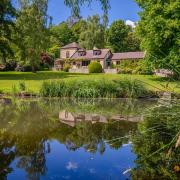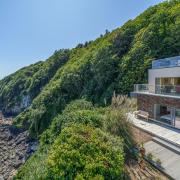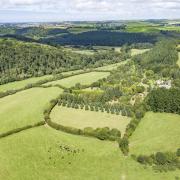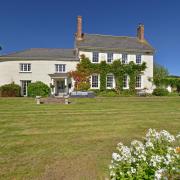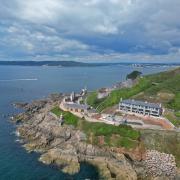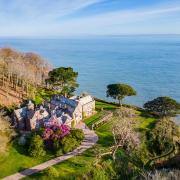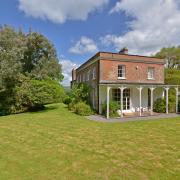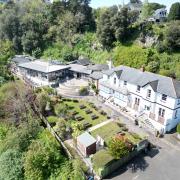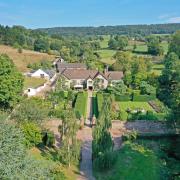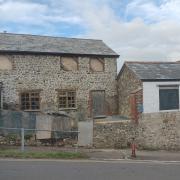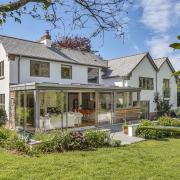Lovingly restored by its present owners, rug-maker Jenny Wilkinson's ancient mill on the edge of Exmoor exudes a timeless charm.
Tucked away down a steep, hairpin lane fringed with wild primroses lies a traditional North Devon farmhouse, which is the home of rug maker Jenny Wilkinson and her family. This is the Devon we all dream about; buzzards wheel overhead, a heron fishes the stream, red deer move silently across sheep-nibbled pasture and the night-time quiet is broken by foxes barking and owls hooting in the woods.
Jenny's home is one of a cluster of stone and cob buildings that snuggle into the hillside at the head of a narrow, twisting valley near South Molton. This valley is at the very heart of the landscape made famous by the evocative photographs of James Ravilious for the Beaford archive. Ravilious' pictures, mostly taken in the 1970s and 1980s, show a way of life that had changed little since the 19th century in this remote corner on the fringes of Exmoor.
Times have since moved on and nowadays even farmhouses sport a satellite dish (TV reception would be impossible otherwise), but the special sense of place remains, and it was this aura of enchantment that first enticed Jenny and her husband, Graeme.
"We moved to Devon from London with our two young children in 1990 and bought a little shop in South Molton," says Jenny. "The funny thing was that we rented a place very near to where we are now, but we'd never been down into the valley. In fact we didn't know it was here. And then one day we saw it advertised in the local paper. The place had been on the market for ages and hadn't been lived in for a couple of years. It was very run-down and covered in pebbledash.
"We bought it because of the location and the fact that it had its own water supply - the most beautiful spring water which rises from a deep source. The house had been neglected but it still had its integrity."
Getting to grips with the problems
The Wilkinsons' first job was to remove the exterior pebbledash so that the house could breathe. Inside, they pulled out masses of plasterboard, uncovering oak ceiling beams and a huge fireplace with a bread oven in the main room. The ceiling beams are distinctly bowed and furniture in the bedrooms above needs to be wedged in place to stop it wobbling on the uneven floor.
Most of the renovation was carried out by Jenny and Graeme, with help from a traditional local building firm, the Tucker brothers (now retired). Their work revealed that the house was built with cob on a stone base, topped off on the upper storey with another layer of stone. Jenny suspects the topmost stone layer was a later addition to raise the roof level, perhaps after a fire. Although the roof is covered in slates, it may once have been thatched. The oldest parts of the building date back to the 1700s, although records indicate there was a dwelling on the site before then. The earliest written reference is from 1649, but some of hedgebanks on the land are around 600 years old.
The main mill house is one of a cluster of ancient buildings which include a cowshed, linhay, cartshed, small barn and the mill building itself. "The place would have operated as a part-time grist mill, part-time farm," Jenny explains. The mill came with 50 acres of pasture, which Jenny uses to graze her own flock of 100 Shetland sheep. She manages the land under the DEFRA Countryside Stewardship Scheme to ensure it is conserved for future generations.
Continuing developments
Over the years, the Wilkinsons have added another building to the site. In 2000 they bought a derelict old barn, which was on council-owned land in South Molton. The structure was little more than a pile of stones and it was going to be cleared, but Jenny and Graeme stepped in to buy it. Working with local builders A&G Setherton from Bishops Nympton, Graeme carefully measured the building before it was transported stone by stone to the mill. Here it was reconstructed in its original proportions and joined on to the main house to form an impressive extension. Preserving the original openings, so typical of a Devon linhay, has created big French windows overlooking the garden, stream and fields beyond.
"The stone is one of the best things about the barn. It's local, but it's got a golden tone, which is quite unusual round here where the stone tends to be much greyer," says Jenny.
Downstairs, a pair of wooden griffins dominates the barn room. These huge carvings were salvaged from a former synagogue in East London when it was converted to a theatre 30 years ago. "They were originally placed next to the Ten Commandments. We think they are made of oak, but you can't be sure because they've been painted. We don't really know how old they are," says Jenny. "We named Griffins Yard, our wholefoods shop in South Molton, after them, and they used to hang there until we sold the business last year when Graeme retired."
Opposite the griffins at the other end of the barn room is a gracious old grandfather clock with painted hunting scenes. Its mellow, polished wood is a perfect complement to the honeyed hues of the natural stone walls. The clock belonged to Jenny's grandfather, who was vicar of St Keverne in Cornwall. It was made in Redruth, some time in the 19th century, by Beringer Schwerer & Co, and is one of a collection of fine antiques that Jenny inherited from her father. She is particularly fond of a pair of Staffordshire spaniels, and a Staffordshire model of King William III on his horse, which decorates her dressing table upstairs.
Throughout the house there is evidence of Jenny's rug-making craft. Hanks of coloured wool hang on the washing line, strange tubs and crocks of homemade dye lurk in the outbuildings and the finished results adorn walls and floors.
Jenny uses all natural dyes for her rugs, many made from plants on the farm. "If there's a suitable plant, I'll try it. I get my cauldron going and see what comes out," she says. Docks, brambles, nettles and bracken all make good greens, while oak galls add a silvery-grey. Her reds come from madder root; yellows from onion skins, while the blues are derived from indigo. These are rich, ancient colours that have been used for dyeing and rug-making for thousands of years.
Jenny generally uses two types of yarn, either 100% British wool - some from her own sheep - or a rare handspun yarn collected in Oman. She loves the Omani yarn: "It's fantastic stuff. It has a wonderful colour, a wonderful texture and is quite eccentric to work with." Rugs made with it are superbly tactile and have a great depth of colour.
Weaving takes up a lot of room and Jenny does hers on a wooden floor loom at The Crafts Gallery, Griffins Yard, South Molton. Visitors can watch her at work and see some of the finished items.
Syzygy
Jenny's next exhibition is at The Alpha House Gallery in Sherborne, Dorset, from 12 April to 10 May. The show, called Syzygy, is being curated by John Makepeace, the UK's leading furniture designer/maker and features collaborations between furniture makers, rug and tapestry designers. Jenny is collaborating with Robert Kilvington, a near neighbour and fellow member of the Devon Guild of Craftsmen. Robert is known for his large-scale sculpture for public places, such as his marvellous green oak bench at Haldon Hill, Exeter.
As fellow sheep farmers in a close-knit community, Robert and Jenny often work together on the land. "Last year's haymaking was typical," says Jenny. "I was on the tractor, cutting, turning and baling with Robert and my immediate neighbour Margaret (aged 76). We then hauled loads of hay to our barns across the fields, with both our families loading and stacking bales. We finished well after dark with a sea mist rolling in, it was a terrific experience."
More details are available from her website, www.craftsgallerygriffinsyard.co.uk.
SARA HUDSTON



